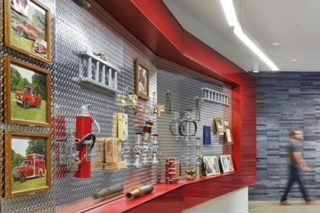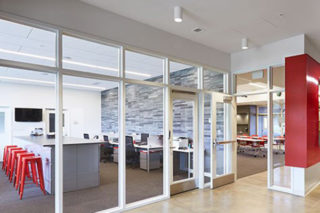Recent Articles
Local fire stations see big gains from thoughtful design
by Cindy McCleary, AIA, NCARB, LEED AP, Public Safety Leader and
Stacy Feit, AIA, NCARB, LEED AP, Architect
In 1679, the city of Boston, Mass., established America’s first publicly funded fire department. By providing this service to the people of Boston, government officials filled the need for trained fire responders for their communities, but created new questions, such as: How would this new fire department be housed? What would this house need to enable the firefighters to perform at their best?
Since that time, firefighting and fire stations have evolved and adapted, based on variables like public need, emerging technologies and funding. Over time, best practices have been established and basic features for modern fire stations have been developed. Nevertheless, the role of firefighters in our communities continues to evolve and fire station design must also evolve to support them.
While there are still basic features that every station needs, thoughtful design features can improve experiences, services and functionality of stations without adding significant cost. Below are a few ideas our LEO A DALY project leaders offer to help your fire station protect and serve your communities, be a welcome addition to the neighborhood and support the needs of firefighters.
Connecting the Past to the Future
“The time for mourning may pass, but the time for remembering never does.”
President George W. Bush after 9/11
Oftentimes, fire stations become pillars of the communities they serve. They are emblematic of pride and service and represent a connection to the past for long-time community members, as well as for the firefighters themselves. However, when it comes time to renovate old stations or build new ones, that connection to the past can get lost amongst the shine and luster of new facilities.
To help maintain the connection to history and to those who have served before, Honor Walls can be used to thoughtfully display photographs, memorabilia and artifacts from the past, maintaining the connection between new and old, as well as the current firefighters to the prior generations. Furthermore, Honor Walls can represent an attraction for both the community and recruits, providing opportunities to visit a new station, to feel a connection to the past and to the future, as well as to instill within them the pride that comes with service to their community.
T he Honor Wall that LEO A DALY designed for the Bayport, Minn., fire station dedicated an entire diamond-plated wall to displaying retired helmets, photographs of old trucks, bricks from the old station, out-of-use equipment and stories of lives saved to help paint a picture of the past and the department’s contribution to the community. Because the memorabilia were already owned by the department, creating an Honor Wall like this was an inexpensive way to help current firefighters understand their shared history while also helping visitors from the community understand and feel connected to their past and its relevance to today.
he Honor Wall that LEO A DALY designed for the Bayport, Minn., fire station dedicated an entire diamond-plated wall to displaying retired helmets, photographs of old trucks, bricks from the old station, out-of-use equipment and stories of lives saved to help paint a picture of the past and the department’s contribution to the community. Because the memorabilia were already owned by the department, creating an Honor Wall like this was an inexpensive way to help current firefighters understand their shared history while also helping visitors from the community understand and feel connected to their past and its relevance to today.
Training by Design
To be at their best when the alarm goes off, firefighters seek ongoing training and practice. Oftentimes, to simulate the real-life situations they may encounter during emergencies, firefighters must construct simulation structures off-site, leaving the station to get there. This is not only time spent away from the station, it is also time away from the vehicles and equipment they may need to respond to a Call-For-Service. And in fire service, minutes save lives.
At LEO A DALY, we are constantly looking for opportunities and cost-effective methods to incorporate training props and structures into our fire station design. Examples of built-in training structures could include a balcony at the second level of a station or hose tower, so firefighters can practice ladder rescues, or building a sacrificial residential roof for use as a training prop to practice opening air vents in a sloped roof from a ladder truck. We have integrated enclosed ladder cages in the apparatus bay, so firefighters can practice climbing, in full gear, in a confined space. We have also included below-grade vaults for additional on-site, confined-space training.
Any of these built-in training opportunities could be expensive to add-on to an existing space, but when included into the design of a renovation, expansion or new building, they can be added at a significantly lower cost. The benefit to firefighters – and by extension to the community – make these built-in training structures an important benefit for the cost.
Being Neighborly
Just as Honor Walls can create a sense of community among firefighters and the public, so can fire station design that makes everyone it serves proud. Without being opulent or extravagant, thoughtful design can help create a connection to the past, integrate training opportunities and reflect the community’s values through the design of a local fire station.
 At LEO A DALY, our design goal is to exceed expectations by creatively maximizing our clients’ investments and innovatively including all the elements needed in a facility to make it functional, livable and inspiring.
At LEO A DALY, our design goal is to exceed expectations by creatively maximizing our clients’ investments and innovatively including all the elements needed in a facility to make it functional, livable and inspiring.
We have an ever-present goal to create beauty in the world around us. We want our designs to instill pride, reflect community values and represent the neighborhoods they serve. Fire stations do become pillars of their communities, so the station’s physical appearance should be one that fits in with its environment and creates a sense of pride for everyone who works there and visits there.
As modern fire stations continue to evolve, so will our thinking about how we can improve our designs. We are passionate about partnering with each community for which we provide fire station design, so we seek first-hand accounts of what citizens and firefighters want and need. We know if we listen to their ideas and translate them with our own experience and expertise, we can create fire stations that meet the needs of today and beyond, and do it within budget.
About the authors
 Cindy McCleary is an expert in visioning and consensus building and is particularly adept at guiding and facilitating special interest groups, public sector clients and multiple stakeholders to realize strategically driven results. Her multi-faceted experience as a programmer and planner has earned her a reputation for advanced thinking and strategically-driven design processes. Cindy can be contacted at 612.341.9588 or camccleary@leoadaly.com.
Cindy McCleary is an expert in visioning and consensus building and is particularly adept at guiding and facilitating special interest groups, public sector clients and multiple stakeholders to realize strategically driven results. Her multi-faceted experience as a programmer and planner has earned her a reputation for advanced thinking and strategically-driven design processes. Cindy can be contacted at 612.341.9588 or camccleary@leoadaly.com.
 Stacy Feit prides herself on listening and understanding her clients’ needs. She specializes in construction document preparation and coordinating multiple disciplines, while maintaining the design intent. Stacy has experience with multiple construction delivery methods. She can be reached at 402.390.4236 or slfeit@leoadaly.com.
Stacy Feit prides herself on listening and understanding her clients’ needs. She specializes in construction document preparation and coordinating multiple disciplines, while maintaining the design intent. Stacy has experience with multiple construction delivery methods. She can be reached at 402.390.4236 or slfeit@leoadaly.com.
